
Cybele, minor planet designation 65 Cybele, is one of the largest asteroids in the Solar System. It is located in the outer asteroid belt. It is thought to be a remnant primordial body. It gives its name to the Cybele group of asteroids that orbit outward from the Sun from the 2:1 orbital resonance with Jupiter. The X-type asteroid has a relatively short rotation period of 6.0814 hours. It was discovered by Wilhelm Tempel in 1861, and named after Cybele, the earth goddess.

1620 Geographos, provisional designation 1951 RA, is a highly elongated, stony asteroid, near-Earth object and potentially hazardous asteroid of the Apollo group, with a mean-diameter of approximately 2.5 km (1.6 mi). It was discovered on 14 September 1951, by astronomers Albert George Wilson and Rudolph Minkowski at the Palomar Observatory in California, United States. The asteroid was named in honor of the National Geographic Society.
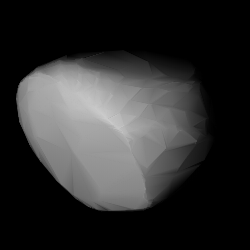
1036 Ganymed, provisional designation 1924 TD, is a stony asteroid on a highly eccentric orbit, classified as a near-Earth object of the Amor group. It was discovered by German astronomer Walter Baade at the Bergedorf Observatory in Hamburg on 23 October 1924, and named after Ganymede from Greek mythology. With a diameter of approximately 35 kilometers, Ganymed is the largest of all near-Earth objects but does not cross Earth's orbit. The S-type asteroid has a rotation period of 10.3 hours. In October 2024, it is predicted to approach Earth at a distance of 56,000,000 km; 35,000,000 mi (0.374097 AU).
1509 Esclangona, provisional designation 1938 YG, is a rare-type Hungaria asteroid and binary system from the inner regions of the asteroid belt, approximately 8 kilometers in diameter. It is named after French astronomer Ernest Esclangon.
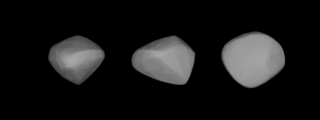
Phocaea is a stony asteroid from the inner regions of the asteroid belt, approximately 75 kilometers in diameter. It is the parent body of the Phocaea family. Discovered by Jean Chacornac in 1853, it was named after the ancient Greek city of Phocaea.
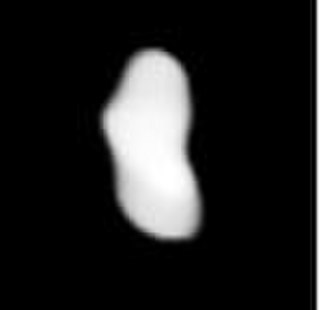
Ausonia is a stony Vestian asteroid from the inner region of the asteroid belt, approximately 100 kilometers in diameter. It was discovered by Italian astronomer Annibale de Gasparis on 10 February 1861, from the Astronomical Observatory of Capodimonte, in Naples, Italy. The initial choice of name for the asteroid was "Italia", after Italy, but this was modified to Ausonia, an ancient classical name for the Italian region.

Elsa is a Massalia or background asteroid from the inner regions of the asteroid belt, approximately 44 kilometers in diameter. It was discovered on 7 February 1878, by Austrian astronomer Johann Palisa at the Austrian Naval Observatory in today's Croatia. The S-type asteroid has a very long rotation period of 80 hours and likely an elongated shape. The origin of its name is uncertain.

Adelheid is a dark Alauda asteroid from the outer region of the asteroid belt, approximately 121 kilometers in diameter. It was discovered by Austrian astronomer Johann Palisa at Vienna Observatory on 17 April 1888. The meaning of the asteroids's name is unknown.

849 Ara is a large, metallic background asteroid, approximately 80 kilometers in diameter, that is located in the outer region of the asteroid belt. It was discovered on 9 February 1912, by Russian astronomer Sergey Belyavsky at the Simeiz Observatory on the Crimean peninsula. The M-type asteroid has a short rotation period of 4.1 hours and is likely elongated in shape. It was named after the American Relief Administration (ARA) for the help given during the Russian famine of 1921–22.
925 Alphonsina, provisional designation 1920 GM, is a stony Hansian asteroid from the central region of the asteroid belt, approximately 58 kilometers in diameter. It was discovered on 13 January 1920, by Catalan astronomer Josep Comas i Solà at the Fabra Observatory in Barcelona, Spain. The S-type asteroid has a rotation period of 7.88 hours. It was named for the Spanish Kings Alfonso X and Alfonso XIII.

1089 Tama, provisional designation 1927 WB, is an elongated Florian asteroid and synchronous binary system from the inner regions of the asteroid belt, approximately 12 kilometers in diameter.
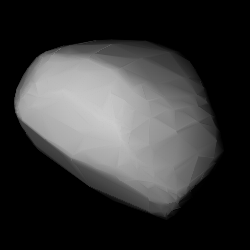
3749 Balam is a stony Flora asteroid and rare trinary system orbiting in the inner regions of asteroid belt. It also forms a secured asteroid pair with sub-kilometer sized asteroid (312497) 2009 BR60. Balam was discovered on 24 January 1982, by American astronomer Edward Bowell at Lowell's Anderson Mesa Station near Flagstaff, Arizona, and received the prov. designation 1982 BG1. It was named after Canadian astronomer David Balam. Balam measures approximately 4.1 kilometers (2.5 miles) in diameter. Its two minor-planet moons have an estimated diameter of 1.66 and 1.84 kilometers, respectively.

1627 Ivar, provisional designation 1929 SH, is an elongated stony asteroid and near-Earth object of the Amor group, approximately 15×6×6 km. It was discovered on 25 September 1929, by Danish astronomer Ejnar Hertzsprung at Leiden Southern Station, annex to the Johannesburg Observatory in South Africa. It was named after Ivar Hertzsprung, brother of the discoverer. 1627 Ivar was the first asteroid to be imaged by radar, in July 1985 by the Arecibo Observatory.
1143 Odysseus, provisional designation 1930 BH, is a large Jupiter trojan located in the Greek camp of Jupiter's orbit. It was discovered on 28 January 1930, by German astronomer Karl Reinmuth at the Heidelberg Observatory in southwest Germany, and later named after Odysseus, the legendary hero from Greek mythology. The dark D-type asteroid has a rotation period of 10.1 hours. With a diameter of approximately 125 kilometers, it is among the 10 largest Jovian trojans.
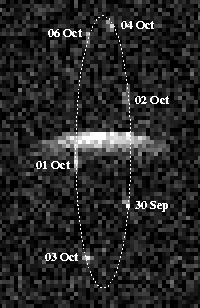
(185851) 2000 DP107 is a sub-kilometer sized asteroid, classified as potentially hazardous asteroid and near-Earth object of the Apollo group that is notable because it provided evidence for binary asteroids in the near-Earth population. The PROCYON probe developed by JAXA and the University of Tokyo was intended to flyby this asteroid before its ion thruster failed and could not be restarted.
5905 Johnson, provisional designation 1989 CJ1, is a Hungaria asteroid and synchronous binary system from the innermost regions of the asteroid belt, approximately 4 kilometers (2.5 miles) in diameter. It was discovered on 11 February 1989, by American astronomer Eleanor Helin at Palomar Observatory in California, United States. Its satellite measures approximately 1.6 km (1 mi) in diameter and orbits its primary every 21.8 hours. It was named after American astronomer and engineer Lindley N. Johnson.
1574 Meyer, provisional designation 1949 FD, is a carbonaceous asteroid from the outer region of the asteroid belt, approximately 59 kilometers in diameter. It was discovered on 22 March 1949, by French astronomer Louis Boyer at Algiers Observatory in Algeria, northern Africa. It was named after French astronomer M. Georges Meyer.
3199 Nefertiti, provisional designation 1982 RA, is a rare-type asteroid, classified as near-Earth object of the Amor group of asteroids, approximately 2.2 kilometers in diameter. It was discovered on 13 September 1982, by American astronomer couple Carolyn and Eugene Shoemaker at Palomar Observatory, California, United States.

1980 Tezcatlipoca, provisional designation 1950 LA, is an eccentric, stony asteroid and near-Earth object of the Amor group, approximately 6 kilometers (4 mi) in diameter.

(164121) 2003 YT1, provisional designation 2003 YT1, is a bright asteroid and synchronous binary system on a highly eccentric orbit, classified as near-Earth object and potentially hazardous asteroid of the Apollo group, approximately 2 kilometers (1.2 miles) in diameter. It was discovered on 18 December 2003, by astronomers with the Catalina Sky Survey at the Catalina Station near Tucson, Arizona, in the United States. The V-type asteroid has a short rotation period of 2.3 hours. Its 210-meter sized minor-planet moon was discovered at Arecibo Observatory in May 2004.














